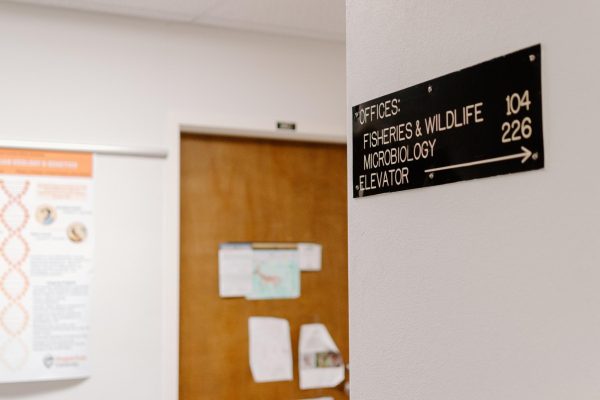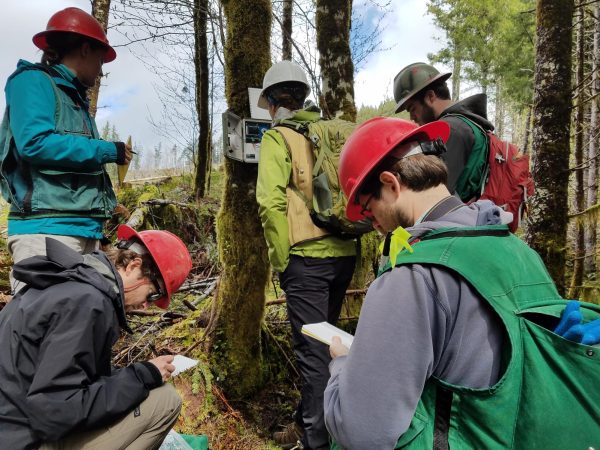4 contaminants found in Corvallis water above EWG recommendations
A photo illustration of water splashing out of a cup on August 4, 2022 in Corvallis, Ore. A recent review by the online community Environmental Workgroup revealed four contaminants, including Hexavalent Chromium, in the Corvallis water supply that exceed recommended guidelines.
August 10, 2022
Although the City of Corvallis is in compliance with federal drinking water standards, The Environmental Workgroup, an online community of over 30 million people that aims to protect the public has recorded that in the Corvallis there are four contaminants found in the water that exceed their recommended guidelines.
According to EWG, the contaminants found in Corvallis drinking water are Hexavalent Chromium, a metallic element that occurs naturally, but may also enter the environment via human activities/industry. Chromium has a variety of uses and is used in electroplating, tanning, printing, and dyeing industries as well as many others. Haloacetic acids (Haa5) and (HAA9) and trihalomethanes (TTHMS) are classes of compounds referred to as disinfection byproducts (DBPs).
Jeff Nason, a professor of Environmental Engineering in the School of Chemical, Biological and Environmental Engineering for the last 15.5 years in addition to being the Associate Head of the graduate program in the school for the last 8 years has a position that focuses on teaching, researching and service.
Nason is familiar with the chemicals found by the EWG. Nason has taught courses on drinking water treatment, physical and chemical treatment processes in addition to air pollution control.
“My research is broadly in the areas of water quality and treatment with a focus on particulate contaminants, aquatic chemistry, and physical/chemical treatment processes,” Nason said.
According to Nason, the pollutants found by the EWG are all on the list of constituents regulated by the Safe Drinking Water Act (SDWA).
“This means that every public drinking water utility is required to monitor for and remove these constituents below regulatory limits,” Nason said.
The water quality regulatory limits in Oregon are set by the US Environmental Protection Agency and enforced by the Oregon Health Authority.
According to the EWG website, Chromium Hexavalent was found in the water system to be .511parts per billion (ppb), with recommended levels of .02ppb. Haloacetic acids (HAA5 & HAA9) were found 16.2ppb compared to EWG recommended level of .1ppb. Lastly, Trihalomethanes (TTHMS) in the water system was at 19.8 PPB while EWG guidelines recommend .15ppb.
Nason was not aware of the EWG standards; with further investigation, Nason deduced that the EWG standards are based largely on California public health goal . According to Nason, public health goals do not consider the technological and economic feasibility of achieving those goals.
On the other hand, regulatory standards set by the USEPA or state regulatory agencies do account for these factors. However, Nason does believe that poor water quality can be detrimental to the environment and humans.
“A reliable source of clean and safe drinking water is essential; we literally can’t live without it,” Nason said.
Nason said that drinking water that has contaminants at levels that can harm your health is clearly undesirable.
Gerrard Jones has been an assistant professor in the Department of Biological & Ecological Engineering in the College of Agricultural Science for the last five years. Jones’s research focuses on water quality with man made and organic chemicals.
“All environmental processes generate chemicals, so in any water or soil sample, there is a chemical record of all the processes that occur,” Jones said. “My research focuses on using statistical and machine learning tools to try to decode the chemical messages that are in the environment.”
Jones is currently working on developing chemical fingerprints that allow his team to diagnose different pollution sources to hopefully improve water quality and more.
“If your water is contaminated with microorganisms (e.g., giardia, cryptosporidium), you can get severe gastrointestinal illnesses that can hospitalize people in the community or worse,” Jones said. “Conversely, continual low-level exposure to contaminants can result in long term health effects both in ecosystems and people.”
Jones admits there is still a lot that people do not know about the health effects of many contaminants.
“People and ecosystems respond differently to exposure. Some people are more susceptible to low water quality because their health is already compromised,” Jones said. “There is no simple answer to say that X water quality will result in Y response.”
Jones and Nason routinely check the water quality report put out by the City of Corvallis. The consumer confidence report is published yearly so citizens can obtain access to all information about water quality in Corvallis.
“According to the 2022 water quality report, chromium was not detected in Corvallis drinking water and both HAAs and TTHMs were well below the USEPA’s regulatory limits,” Nason said.
EWG states that legal limits for HAA is 60ppb and TTHM is 80 ppb, which is well above both EWG and Corvallis water quality reported levels. The Corvallis water quality reports also provide a list of contaminants that were tested for but not found in the water.
“At the levels that are present in drinking water, the risks associated with these byproducts are far lower than the risks of getting a gastrointestinal illness, so while drinking harmful chemicals is always a concern, Corvallis tap water is safe to drink.” Jason said.
Nason believes that the federal regulations are higher than the EWG standards for one or more of several reasons.
“One, there may be an inability to accurately/routinely detect compounds at such low concentrations; two, there may be a lack of suitable technology to remove compounds to that low of a level; three, the cost of removing compounds to those levels has been determined to be too high; or four, the science defining the risk of the constituents is unsettled,” Nason said.
Although the EPA has an established process for determining these guidelines, Jones does not think that one threshold can be universal.
“There is no one threshold that satisfies everybody’s needs. One could argue that we should use the most strict standard and use the best available technologies (e.g., reverse osmosis) to deliver the highest quality water,” Jones said.
Jones believes that there are a lot of known toxins that are not regulated.
“I am certain there are toxic chemicals that are present that are not being monitored,” Jones said.
Jones admits that these chemicals are probably found in trace amounts with low risk.
“The city would not be able to afford to analyze all known toxic chemicals. Corvallis monitors for a broad suite of chemicals, and while it is not comprehensive, it is probably a decent subset of chemicals that might give us a clue that something was wrong.” Jones said.
Nason does admit that states have the ability to move faster than the federal government when creating guidelines.
“I think some of the most problematic contaminants are things like lead which we do have lots of good toxicological data on and that typically enters drinking water from legacy plumbing in distribution systems and household plumbing,” Nason said. “Utilities do sample homes, but not every home. As such, it is often left up to individuals to test their own water to identify the problem and then to either replace their lead plumbing or install a point of use filter.”
Jones admits that some chemicals have no known safe limit, like lead, which is why Jones is concerned about finding lead in the water compared to other contaminants.
“Lead is a good example, but lead can be introduced through a variety of ways,” Jones said.
According to the Corvallis report lead was found in homes at 1.4 micrograms per liter, which is within legal limits. Although Jones is concerned about Lead in drinking water, Jones is concerned about Nitrates and phosphorus.
“Nitrate is one of the most widespread and problematic pollutants that are present in water,” Jones said. “Nitrate and phosphorus are common nutrients that are contributing to harmful algal blooms, which are becoming more widespread and prevalent in lakes and rivers.”
Nitrate was tested and not found in the water system according to the City of Corvallis. However, the EWG found Nitrate in the water system at levels that comply with their recommendation.
Both Jones and Nason believe that Corvallis has good high quality drinking water.
“We are really privileged to live in Corvallis for its drinking water,” Jones said. “There are, however, recent examples of how municipalities have ignored signs of poor water quality problems, but even if we could test for all known toxics, there are many more unknown toxins that could cause problems.”
Corvallis drinking water comes from two surface water sources. According to the City of Corvallis water quality report there are three creeks in the rock creek watershed that supply water to the Rock Creek Water Treatment Plant. In addition to the Willamette River which supplies the Taylor Water Treatment Plant.
Tom Hubbard, Utilities Division Manager for the City of Corvallis Public Works department states that the Taylor treatment plant utilizes granular activated carbon to filter water.
“The Taylor plant has eight filters: four are dual media Granular Activated Carbon and sand, and four are multimedia Granular Activated Carbon sand and garnet. The filters can filter up to 21 million gallons per day,” Hubbard said.
The Rock Creek plant utilizes two multimedia filters that utilize anthracite, sand, and garnet. According to Hubbard, the filters can filter up 5 million gallons per day.
“I wouldn’t say that I worry about any common pollutants in Corvallis because I do trust our water utility and the federal regulatory structure,” Nason said.
Scott Kruger, has been a registered environmental health specialist with Benton County Environmental Health for the last 18 years and has been the manager of Environmental Health for the last 2 months. In addition to a few other positions, OSU Alumni Kruger from the class of 1999 is in charge of the oversight and regulation of water systems that utilize groundwater within populations of less than 3,300.
Although Kruger does not directly oversee Corvallis systems, he points out that all public water system evaluation results are posted online to the Safe Drinking Water Information System (SDWIS) for public viewing.
“Public water systems have access to DWP services to evaluate potential sources of contamination in the aquifer recharge area. It’s called a source water assessment,” Kruger said.
Kruger does agree that the testing for water does vary depending upon the water system type.
“Contaminate action levels are also varied. A community water system in Oregon would be required to test for bacteria monthly, nitrate annually, IOC, SOC, VOC and Radionuclides on varied schedules.” Kruger said.
All Oregon public water system information is posted on the Safe Drinking Water Information System (SDWIS) website.
“It is impractical to say that requiring facilities to generate pure water without any contamination is probably impossible at this moment. If we employed every single technique we had, it would be exceedingly expensive and wasteful,” Jones said.
There is a dedicated staff of city employees whose job it is to ensure that consumers have an uninterrupted supply of clean and safe drinking water.
“I would encourage everyone in the OSU community to learn about where their water comes from, how it is treated, and the journey it takes before arriving at your tap. My hope would be that this education would lead to increased efforts to protect our precious water resources by preventing pollution and protecting the health of our waterways,” Nason said.
























































































































